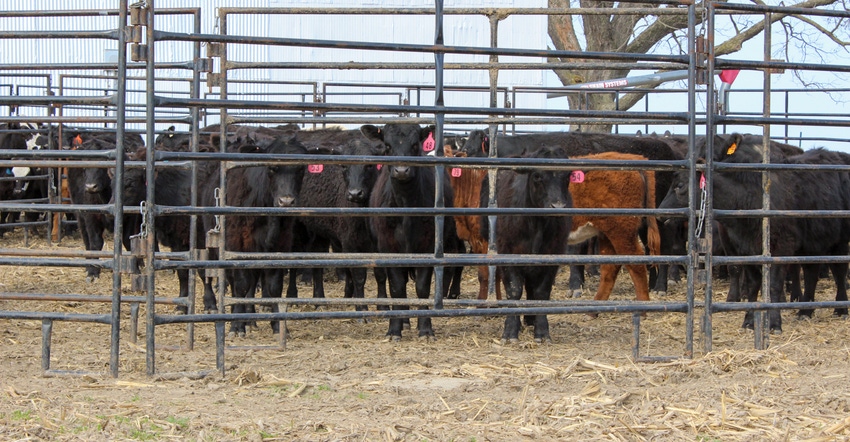Should you grow bigger beef calves amid pandemic?
Meat processing plant shutdowns make for hard cattle decisions in the nation’s heartland.

The beef industry is in upheaval, and while it will take time to decide what shoulders the most blame — COVID-19 or the meat packing industry — beef cattle producers face a difficult question right now: “What should I do with my calves?”
Wesley Tucker, University of Missouri Extension ag economist, struggles with an answer. “So, if you can tell me when we're going to get our country back to work and how bad the unemployment is going to be when this all shakes out, I could do a lot better job of giving you a straight answer on this,” he says. “Right now, there's just so much volatility in the market.”
He says there is a difference in how beef farmers should handle yearling feeder calves and fall weaning calves during the COVID-19 beef market disruption.
Related: Complete coronavirus coverage
Beef market situation
In the short term, what the cattle industry is facing and what is causing its market to tank is the shutdown of beef processing plants as COVID-19 spreads into the heart of the country.
Those that are not closed, Tucker says, are limited to only one shift to try to keep workers healthy and reduce exposure to the coronavirus.
“But what really makes us worse,” he says, “is we have such a limited slaughter capacity in this country right now. I think we're 90,000 less last week than we've processed the week before, and this week we're running at a much slower chain speed.”
With fewer plants and less capacity, farmers are forced to hold cattle either on the farm or in the feedlot, pushing slaughter weights higher. It has really caused fear through the futures markets, Tucker says, and the futures market prices have dropped.
“Anyone that's looking to put cattle in the feedyard,” he says, “I mean, most lenders today won't allow you to put animals in the feedyard unless you can hedge them.”
With the current futures markets forecast out, lenders must back up the bids for the feeder calf and calf prices because they cannot hedge them right now, Tucker explains. “There's just way too much (beef cattle) ready, and our projected closeouts are really difficult.”
He says in the short term, if processing plants can keep going, then “prices should in theory rebound.” But he looks back to the Tyson Foods’ Holcomb, Kan., plant fire last year and reminds farmers that it took almost 100 days for the market to return to some sort of normalcy.
For beef farmers with feeder cattle ready for slaughter wondering if they should hold calves, grow them larger and sell later in the year, Tucker offers a little advice.
Grow bigger cattle
“Well, we would like to think that that's a good strategy,” he says. Traditionally, the best time to market those heavy yearlings tends to be in late summer. However, he warns, this may not be the case this year because of the COVID-19 market disruptions. Actually, there is a risk to growing larger calves.
If farmers have some heavyweight feeder cattle that are pushing eight-weight, the futures market shows the May contract as low as the current April contracts. Why?
“The reality is, right now, very few people are selling animals through the option markets,” Tucker explains. “So, what few feedlots do have some openings and do want to buy some cattle have very few to choose from.”
He says beef producers need to realize that when plants go back online and all of the cattle that are backed up on farms and feedyards head to market, “Prices could actually go down for the heavyweight feeder cattle going forward.”
Cheap gains on young calves
Tucker is not as concerned about beef farmers holding on to weaned fall calves.
“This is a good time to put some cheap gains on those cattle, taking advantage of the grass flush that we have this time of year,” he says. “The market is typically paying us fairly well for backgrounding those calves and making them heavier or even just preconditioning those calves.”
Tucker says he is not as concerned about heavy yearlings in 60 to 90 days, but would be “very cautious about trying to sell calves at drastically reduced prices.”
Ultimately, he warns that the market reacts to supply and demand. Right now, there is too much beef supply, and meat in general, on the market. However, the price in grocery stores for beef remains high.
As the COVID-19 pandemic continues and unemployment rises, Tucker says people likely will look for ways to cut expenses. Often, they choose cheaper protein sources other than beef and demand may decline.
“I’m really concerned about the long-term demand for beef,” he says. “If unemployment skyrockets, we’re going to be in trouble.”
About the Author(s)
You May Also Like




.png?width=300&auto=webp&quality=80&disable=upscale)
